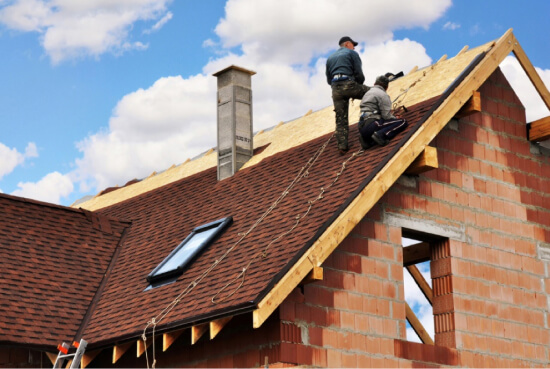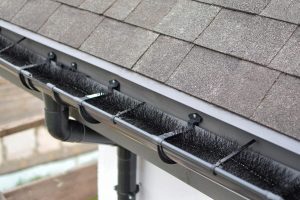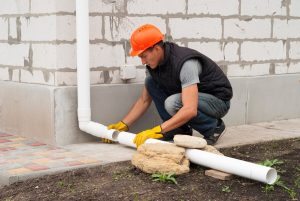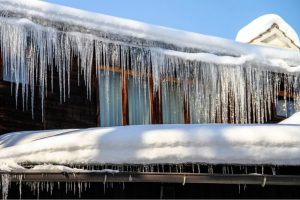Is it Time to Repair your Roof?
Jun 9, 2023

Roof repair varies in complexity, which means some can be handled by homeowners and others by professionals only. Most of the easier damage to repair is leaks, but some types of leaks still require expert skills to fix.
To determine if it’s the right time to replace your roof, there are several factors you’ll have to consider. You may want to start looking out for obvious signs that your roof needs a replacement. They include excessive wear and tear, loss of granules, excessive damage after a storm, severe leaks and issues that arise due to poor installation. In many cases, roofing is replaced when repairs are no longer a valid option.

Popular roofing materials like asphalt shingles need proper maintenance and annual inspections to help extend their lifespan. Major repairs may not be needed if the roof hasn’t been exposed to storm damage and is yet to exceed its service life. However, if a storm-related event such as hail or high winds occurs, the roof should be inspected to determine if there’s a need for a replacement.
Don’t overlook some areas of your roof
There are some areas of your roofing that can easily be exposed to damage but go unnoticed. They include areas such as the chimney, pipe jacks, attic vents, and furnace. If poorly maintained, these areas may contribute to serious leaks that damage your roofing material forcing you to replace the entire roof.
Preparing a roof before a potential storm hits
Before the storm season begins, it’s important to reach out to a local roofing contractor to have an inspection done. Preventative maintenance and inspection are key if you want the roof to get through the stormy season. It’s an easy way to reduce the need for a replacement after the storms.
Find the ideal roofing material
There are so many options to choose from when it comes to roofing materials. Asphalt shingles remain the most affordable for residential roofing. You may also want to choose a roofing material that has a longer lifespan such as metal and tile. It all depends on your budget and needs.
Over time, all roofs will require replacement due to excessive deterioration. However, some roofing systems need a replacement before they reach their full-service life. Replacing your roof too soon can be a waste of money. Waiting too long can cause serious roofing problems like leaks and costly water damage. That’s why you need to figure out when the best time to re-roof is.

21 Critical factors that help determine if it’s time to repair/replace your roof
Paying attention to the warning signs for your roofing repair can help you save a lot of money and prevent a lot of problems in the future. Popular signs that many homeowners notice first are missing granules and shingles, growing moss, and curling shingles. If you’re wondering should you repair or replace your roof, the extent of the damage can help you make a choice.
- Wind damaged roof.
Most roofs that are damaged by wind are usually difficult to notice. In most cases, the destruction occurs in sections that are not visible from the ground, which means you have to climb a ladder to find out if the shingles are still intact or have been moved by wind. Also, check for loosening of nails and sealant used to secure the shingles, all of which means you have to replace the roof.
- Missing Granules.
It is natural for roofs to lose granules, but it should happen gradually. New roofs should have all the granules intact and should not have patches on them, which may appear dark or light depending on the type of shingles you have. Check the gutters as well for the presence of granules.
Although the roof’s water resistance may not be affected by the loss of granules, you still need to have the roof inspected to ascertain the extent of the damage. Remember, the granules protect the shingles from damage by UV rays, which promotes their longevity. Therefore, their loss means faster wearing and tearing of the roof. The number of granules left and the age of your roof will determine whether you should get a new roof installed.
- Moss growth.
Roofs that are not exposed to sunlight are a perfect habitat for moss. The algae can start thriving even if the roof is still new, provided the conditions are conducive. Although they do not cause structural damage, they can retain water that eventually damages the roof shingles. The problem can be excessive during winter when freezing temperatures causes the moisture to destroy the granules protecting the asphalt in the shingles. Leaving moss on the surface for longer will also eventually lead to roof leaks.
The cosmetic appeal of the roof can be restored by cleaning the areas covered by moss, but the chances of the moss growing back are very high. Also, be cautious not to damage the shingles as you brush them off.
- Roof Cement.
Although not common, roof cement can sometimes be used on the areas that join shingles with other roof sections. Some roofers ignore metal flashing in a bid to save time, slathering concrete at the intersections between the chimney or walls and the shingles. The alternative may work for a short while, but problems will start arising as soon as the cement dries up. It will harden and crack, leading to leaks in those sections. If it remains unattended for long, the problem will reach the interior structures of the roof and house. Repair always works, but it has to be done properly.
- Your roof doesn’t have chimney cricket.
When your roof has a large chimney, debris can easily collect under it and retain moisture. With time, the flashing will begin to rot, and the wood may also start to rot. The best solution for a wide chimney is a cricket. Anything more than 30 inches should have a small roof or saddle built to shield it.
When installed correctly, the cricket will prevent the accumulation of debris around the chimney and ensure water is directed to the roof, where it can flow to the gutters. One of the early signs that you need a cricket is rusting around the flushing. If the roof has been extensively damaged, you can replace it and insist on the saddle being put in place. If not, you can repair the damaged area and ask the roofer to install the cricket.
- No Kick-Out Flashing.
Buildings require kick-out flashing at the intersection between the roof edges and the sidewalls. Without one, water runoff from the roof will damage the exterior wall surface and, in worst cases, penetrate to the inside parts of the wall. In most cases, severe interior damage is caused in places with windows or doors that allow water penetration through the trims. The problem can advance slowly and go unnoticed until it becomes too extensive. By then, your framing and sheathing will have been destroyed, forcing you to replace the entire wall.
Check for stains on your walls and install the kick-out flashing. You will save a lot of money and have peace of mind knowing your roof is fixed and the walls are well-protected.
- Roof missing gutter apron.
When it rains, and water flows from the roof, some droplets remain stuck on the shingles, and they dribble to the fascia. A gutter apron can stop this from happening, even if you have an efficient gutter system in place. It is the only way to keep the water from causing the fascia boards to rot. Other roof elements like soffits and sheathing will also be protected.
Water stains below the gutter are generally the first sign that your roof needs a gutter apron. Such signs may not necessarily indicate the need for a new roof, but it shows that you need to make some adjustments to avoid expensive repairs in the future.
Typically, new gutter aprons should be added when new shingles are being installed. However, professional roofers can still install them on the shingles that are already there. A touch of cement may be used after every two feet to glue the shingles to the roof. The gutter brackets must be removed to allow for the installation of the aprons before they are placed back. You can purchase the gutter aprons at your local home hardware stores.
- Plumbing vent boots are damaged.
Vent boots are made with different materials such as plastic, metal, metal and plastic, or two-piece metal units. Signs of damage will differ depending on the materials you have. For instance, plastic vent boots will become cracked, while metal ones will have broken seams. Inspect the rubber boot, which can become rotten or torn when assessing them for damage. Regardless of the sign, dysfunctional vent boots can allow water to get into the house and destroy the ceilings or attic.
Replace the vent boots instead of waiting to replace the entire roof. If it is still in good condition and the nails are missing, you can exchange them with rubber screws, which are ideal for metal roofs.
Contact our professional team for specialized services that will ensure your vent boots remain in perfect condition for optimal protection of your roof.
- Fix walls and dormers.
Although rainwater falls from the roof most of the time, sometimes, it gets in between the siding, windows, and corner boards when it is driven by wind. If you have dormer walls, the chances of water penetrating the roof are very high. They make it easy for the water to dribble down through multiple spots, which will eventually cause many problems. Cracked and old caulk can make the issue worse. Look for missing caulk around the corner boards and between the siding and window edges to ensure it is still effective in sealing those adjoining surfaces.
Sometimes caulk that looks like it is intact can also cause problems and allow water to seep through. They may be weak, eventually allowing penetration of moisture behind the flashing. To confirm sealing, use a putty knife to poke the area. Remove any caulk you suspect is no longer functional and replace it with silicone latex caulk.
Inspect the area above the step flashing to ensure the siding there is not stained or damaged. Replace pieces that are decayed, missing, or cracked, making sure they overlap perfectly by at least 2 inches. Check the flashing at the corner, too, if leaks persist. In some cases, old caulk will overlap at the corner boards, allowing leaks to continue. Sectional fixes are usually sufficient to prevent further issues.
- Your roof is streaked with black stains.
Black stains commonly found on roofs and walls are a type of algae known as Gloeocapsa magma. They usually start as blue-green, but as they progress, they become darker because an outer layer develops on them. The algae thrive on limestone, which is why they are mostly found on shingles.
The longer they remain in place, the more they worsen and become more visible. Once they accumulate excessively, they will start trapping more moisture that will cause the shingles to age quickly. You can choose to ignore the streaks if they do not bother you, in which case you can install copper strips on the roof. Rainwater that washes over the strips will keep algae and fungi from growing on the roof. It may not eliminate the streaks that are already there but will hinder new ones from appearing. If the lost visual appeal bothers you, replace the damaged shingles with algae-resistant ones.
- Hail damage.
Asphalt shingles are susceptible to damage by large hailstones. In most cases, such hailstorms cause minimal punctures or tears to the shingles, but they can also knock off a few granules from the roof. The shingles will then lose their protective layer and remain open to ultraviolet rays. Once an area begins to deteriorate, more granules will fall off from it, and the problem will keep extending. Such damages can easily go unnoticed for longer, which is why you should contact D’Angelo & Sons for professional and thorough inspections. We will make sure we identify the root cause of the problem and implement the correct measures to mitigate it.
- Ban chimney flashing.
Bad flashing does not have counter flashing and step flashing to protect the sides of the chimneys and the grooves. Counterflashing also protects the step flashing, but installing them is an extensive process that requires a high level of expertise. They have to be cut and fitted correctly. Otherwise, they become less effective.
When the installation is incorrect, the flashing will cause rotting of the sheathing and framing. Caulking or using cement to seal the area will not be sufficient to keep the water out. The right installers will know how to place them so that water does not reach the attic from the chimney.
After a heavy downpour, water flooding the attic is usually a sign that the flashing is not in good condition. Check the area around the chimney, especially if there are stains indicating water has been flowing downward.
- Roof vent issues.
A common sign to look out for in plastic roof vents is cracking, while for metal vents, it’s breakage. Most homeowners consider applying caulk on them as the first remedy, but that will not give you the long-lasting solutions you need. The only cost-efficient restoration is replacing the damaged components.
While at it, make sure to check for loose or missing nails at the edge or bottom of the roof. If you find any, replace them with those made of rubber because they are safe and durable for metal roofs. Be careful as you remove the nails so you do to cause more damage. Pull them from the shingles on both sides of the vent. Pay attention to the nails at the top of the vents as well, and if possible, remove them without removing the shingles. With the right approach, you will not have to replace your roof.
After putting in the rubber-washered screws, place some caulk underneath the shingles on each side of the vents to give them extra protection from moisture and keep the shingles in place.
- The extent of the roof leak.
The slightest leaks on any section of the roof should be enough to warrant a thorough inspection. An assessment will help you determine the cause of the leak and how bad it is. In most cases, leaks occur because of poor flashing, especially the points that are difficult to reach and waterproof. If specific sections are the problem, you can fix them easily without interfering with the whole roof. However, if there are multiple areas, replacing the roof can prevent subsequent repairs in the future. Leaks can also result in ice dam formation when the temperature fluctuates in winter.
Installing quality flashing can prevent sectional leaks from rainwater and ice dams. Hiring a professional is always the best option, but you can also try to do the job as a DIY. Take off all the shingles until you reach the wood sheathing, then put in an adhesive strip serving as an ice and water barrier. They are easily accessible and can be bought with other roofing products. Place them under the soffit or main roof joint. Be careful with the location, which means you should be ready to cut a portion of the sheathing to create enough room for you to slide the strip further in. It should not replace the existing ice and water layer below – it should overlap it. Do this on the sections most susceptible to leaking.
Put back the shingles and place the step flashing beneath the fascia. Make sure the valley flashing is correctly placed at the joint between two roofs and overlapping the step flashing by at least two inches.
If the above solution does not work, try heating cables on the edge of the roof. Check the insulation and ventilation as well to ensure they are up to par. These will help prevent leaks associated with ice dams.
- Damaged shingles.
Broken or missing shingles can cause multiple problems in the roof, but they are mainly associated with leaks. Replacing the problematic pieces as soon as possible is one way of dealing with the issue quickly, but you should strive to understand the root cause before attempting any kind of repair. Replacing them is a simple process that does not require changing the whole roof or calling a professional.
- Are you planning to sell the home in the next few years?
Potential buyers tend to focus on roof conditions when searching for properties to invest in. If you intend to sell your house in less than 10 years, repairing the roof will be beneficial. If it has not reached or is not nearing its lifespan, you can do slight repairs. If you want to continue living there and probably pass the property to the next generation, replace the roof.
- The roof’s energy efficiency.
Your roofing system is the first defence you have against natural elements, but it should also help you save money on energy consumption. New roofs are usually great at reducing the energy used for cooling and heating, but as they deteriorate, the energy consumption increases. So a replacement may give you the long-term efficiency you need.
- Improve the roofing system quality.
If you are no longer satisfied with the quality of your roofing material, exchange it for a better one. Most of the older roofs have lower quality than the modern ones. As such, the older the house, the more you are likely to experience roofing problems. Investing in a new roofing material can help you save a lot of money in the long run by giving you the resilient and durable material you deserve. Making such an improvement is more crucial if you live in an area with severe climatic conditions. A better roof will withstand the harsh weather.
- Your roof’s age.
Most roofing materials have an average lifespan of 20 years. Most of them, like asphalt shingles, will start exhibiting problems after 15 years. They can last longer depending on how well they are maintained. As they near their lifespan, you will begin experiencing recurrent issues that can be expensive over time. Replacing them can save you the trouble of searching for a roofer regularly or spending a lot of money within a prolonged period.
- Removal or adding an extra layer?
Sometimes roof repairs require adding another layer to the existing roof, which is a cheaper and faster solution but comes with the possibility of damages being hidden. You may not notice holes or other problems with the sheathing if you add another layer on top. Removing the existing roof is another method, but it is labour-intensive and expensive. You can choose the option that is ideal for your situation, depending on your budget and future goals. Either way, D’Angelo & Sons will get you the best results.
- Spending money on too many repairs?
Repairs may seem like quick fixes, but they are very costly. If your roof starts needing frequent repairs, consider a replacement. Your roofing contractor can inspect them and give you a lasting solution. Installing a new roof may seem like an expensive venture, but it has proven to be the better option over time. Consult our technicians today for superior roofing solutions.
Repairs are less costly but think of them as a short-term solution. A new roof could be a huge investment in terms of costs but it will serve you for years.

Roof Repair Tips That Will Save Your Day
1. Roof Vents Can’t be Overlooked
How to fix roof vents depends on the problem and the extent of the damage. In most cases, signs of roof vent damage are broken seams on metal vents and cracking on plastic ones. These issues can be temporarily repaired with caulking, but a permanent solution would be to replace the vents.
Another easy shingle repair to try is looking for missing pieces at the bottom part and replacing them with rubber-washers ones.
Removing nails from both sides of the shingles allows separation of the vents, but sometimes the nails on top of them can be removed without interfering with the shingles. After putting in the new screws, use caulk on both sides of the vent beneath the shingles to provide water resistance. The caulk will also hold down the shingles, which is easier than having to nail them back in.
2. Simple Trick to Find the Leak
Sometimes it is impossible to identify a leaky roof until the damage reaches other parts of the house. If there are any stains to indicate the presence of a leak, check elements that penetrate the roof, such as chimneys, vents, and dormers. In most cases, areas of the shingles interrupted by these elements are the most problematic, even in new roofs. Those areas will have water stains and mould growth that point towards the source of the problem.
For leaks that are difficult to locate, ask for help from someone else and use a garden hose to soak the main suspected area. The assistant can stay inside the house to look for the exact location of the leak. Move the hose to various sections of the roof, letting it run for several minutes in each area.
The trick to finding a leaky roof is simple, but it requires a lot of patience. If using a hose does not yield results, you can start removing the shingles in the area you suspect. The discolouration on that place will serve as the proof you need and help you find the source of the leak.
3. Take Care of Dormers and Walls
In most cases, water does not always come through the shingled roof surface, but it comes in from the areas above the roof. The sections around the windows, between corner boards and sidings, or cracks and knotholes in the siding can all allow water to seep into the house. Once it penetrates through the cracks, it reaches the flashing, especially where there are dormer walls.
If caulk on the dormer walls goes missing, cracks, or wears off due to old age, the areas between the window edges and the siding become vulnerable to water damage. Sometimes caulk that looks okay can still fail to provide sufficient sealing for the adjoining areas.
Using high-quality caulk is one of the best dormer leak repairs because it is typically enough to ensure the walls and dormers remain protected throughout the year. Remove all the caulk you think is no longer functioning as it should and check the area above the step flashing. Replace all rotten or damaged siding and ensure the new ones overlap the step flashing by at least 2 inches.
If these don’t work, look for hardened caulk on the overlapping flashing at the corner.
4. Small Holes Are Damaging
Tiny holes are some of the worst problems to have because they can easily go unnoticed. Most people do not recognize them for many years until they become larger or cause the roof to start decaying. The holes can come as a result of the mounting of a satellite dish, antenna, or any other important element in the house.
To patch a hole in my roof, I use caulk that I inject directly into the spaces. It is important to remove misplaced nails during the repair to ensure the problem does not recur.
5. Step Fleshing is Helpful
Step flashing is usually installed on roofs that intersect with the walls. The main role of the flashing is to redirect water over roof shingles towards the gutters. The problem with step flashing usually occurs when the piece rusts or loosens, allowing water to run behind it and seep into the house.
One of the top roof repair tips to consider is replacing corroded or damaged flashing. It involves removal of the shingles and the siding, and putting a new flashing in place or repairing the old one. The trick is to remember to install all the step flashing needed. Failure to do so will eventually result in the exposure of the wall.





